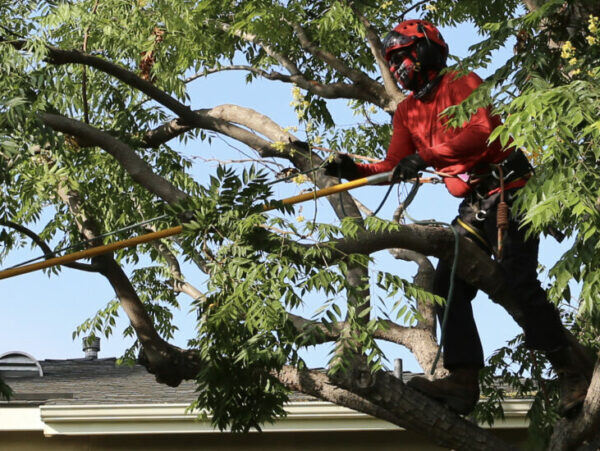Tree pruning is a vital aspect of tree care and maintenance. It involves the selective removal of branches and limbs to enhance the health, aesthetics, and safety of trees. Many homeowners attempt to prune their trees themselves, it is often best to seek the expertise of professional tree pruning services. This article explores the significance of hiring tree pruning professionals, highlighting the benefits they provide and the role they play in ensuring optimal tree health and safety.
Understanding Tree Pruning
Pruning is the process of removing specific branches or limbs to improve tree structure and promote overall health. It involves careful consideration of factors such as the tree’s species, age, growth patterns, and the desired outcome. Pruning can be categorized into two main techniques: pruning for tree health and pruning for aesthetics.
Pruning for Tree Health
Pruning for tree health primarily focuses on removing diseased, dead, or damaged branches. These branches can pose a risk to the overall health of the tree. By identifying and removing these compromised branches, professional tree pruners help prevent the spread of infections, promoting a healthier tree.
Furthermore, pruning for tree health involves the removal of weak or crossing branches that can lead to structural issues. These branches can be prone to breakage during storms or high winds, posing a safety hazard to people and property. Professional tree pruners have the expertise to identify and remove these potentially hazardous branches, reducing the risk of accidents and damage.
Pruning for Aesthetics
Pruning for aesthetics focuses on enhancing the visual appeal and symmetry of trees. By selectively removing branches, professional tree pruners can shape and define the tree’s natural form, creating visually pleasing landscapes. This technique is particularly useful for ornamental trees, where the aesthetic appeal is a significant consideration.
The Benefits of Tree Pruning
Enhancing Tree Health:
Disease and Pest Prevention: Regular pruning helps to identify and remove diseased or infested branches, preventing the spread of diseases and pests throughout the tree. By addressing these issues promptly, tree pruning professionals contribute to the long-term health and vitality of trees.
Increased Air Circulation
Proper pruning improves air circulation and sunlight penetration, reducing the risk of fungal infections and promoting healthy growth. It allows for better access to sunlight and ensures that lower branches receive adequate air and light, enhancing overall tree health.
Structural Integrity
Pruning removes weak or damaged branches, reducing the chances of limb failure during storms or strong winds. By eliminating potential risks, professional tree pruners help maintain the structural integrity of trees, promoting their longevity.
Stimulating Growth
Strategic pruning techniques can encourage new growth in specific areas, leading to a more balanced and robust tree structure. Professional tree pruners know how to selectively prune branches to stimulate growth where needed, resulting in healthier and more vigorous trees.
Aesthetics and Landscape Enhancement
Shape and Form: Pruning allows for the shaping of trees to enhance their natural form, creating visually appealing landscapes. Professional tree pruners have an eye for aesthetics and can carefully trim branches to achieve desired shapes, resulting in visually pleasing trees that complement their surroundings.
Clearing Obstructions: By removing branches that obstruct views or pathways, pruning enhances the overall aesthetics of the surroundings. It allows for better visibility, improves natural light, and creates a more open and inviting environment.
Flower and Fruit Production: Pruning can stimulate flower and fruit production in certain tree species, adding to the beauty and functionality of the landscape. By selectively pruning and shaping the tree, professionals can optimize the tree’s ability to produce flowers or fruits, enhancing its ornamental value and contributing to the overall attractiveness of the landscape.
The Role of Tree Pruning Professionals
Expert Knowledge and Experience
Tree Identification: Professionals possess in-depth knowledge of various tree species and their specific pruning requirements, ensuring the correct techniques are applied. They can identify the unique characteristics and growth patterns of different trees, allowing them to tailor their pruning approach accordingly.
Pruning Methods: Professionals are trained in the latest pruning techniques, ensuring the optimal balance between tree health, aesthetics, and safety. They understand the precise cuts and angles required to promote healing and minimize the risk of damage to the tree.
Timing and Seasonality: Tree pruning professionals understand the appropriate seasons for pruning different tree species. They are familiar with the specific growth cycles of trees and know when it is best to prune to achieve the desired outcomes without compromising tree health. This knowledge helps to maximize the effectiveness of pruning efforts.
Safety and Risk Mitigation
Equipment and Tools: Professionals are equipped with specialized tools and equipment required for safe and efficient pruning. They have the necessary tools for reaching high branches, making precise cuts, and safely removing pruned branches. This minimizes the risk of accidents or injuries associated with using inadequate equipment.
Climbing and Working at Heights: Tree pruning often involves working at heights, which can be hazardous for inexperienced individuals. Professionals are trained in safe climbing techniques and follow strict safety protocols. They use safety harnesses, ropes, and other equipment to ensure their safety while performing pruning tasks.
Long-term Tree Care and Maintenance
Regular Assessment: Tree pruning professionals conduct thorough assessments of tree health, identifying any underlying issues that may require attention. They can spot signs of diseases, infestations, or structural problems that may not be immediately apparent to homeowners. Regular assessments help catch and address issues early, preventing them from escalating into more significant problems.
Corrective Pruning: If a tree has structural defects or improper growth patterns, professionals can implement corrective pruning measures to prevent further complications. They can strategically prune branches to improve the tree’s structure, promoting proper growth and reducing the risk of future damage.
Proper Disposal: Tree pruning professionals ensure the proper disposal of pruned branches and debris, maintaining the cleanliness and aesthetics of the property. They have the means to remove and dispose of the waste responsibly, leaving the property neat and tidy after the pruning process.
